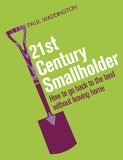
Smallholdings
21st Century Smallholder is a little book with a big agenda as much as we yearn to be free, most are pinned down by lives, jobs, families, fears, inside our urban or suburban homes. So what can we do instead? How do we turn a negative into a positive? This book tells you what to do if you have a small flat and want to grow food in window boxes, as well as a giving you a month by month guide to running a full-size garden or an allotment as a bio-diverse, organic fresh food resource.
Food writer Paul Waddington has turned his own urban back yard into a mini market garden, and this brand new book starts with a good rant against the mega food corporations supermarkets and agribusiness. But as Waddington reminds us, we have become de-skilled in this specialised, industrialised and commercialised world, and we don’t know how to the things which came naturally to our parents and grand-parents growing and preserving vegetables and fruits, perhaps keeping a couple of chickens (enough for an egg a day, if not more) or a larger creature.
As a result we not only lack skills, but also implements, and even the little bits of land we own are not set up to produce food. So there are start-up costs, and sacrifices. But the rewards are a sense of pride and the taste of your own food, picked a few seconds before it goes on the table. And there is an element of survivalism if you are lucky enough to have half an acre of land at your disposal because some time in the next few years the food supply could be disrupted by anything from an energy crisis to Bird flu pandemic to a terrorist alert to weird weather. Even the average garden is big enough to produce a phenomenal amount of food if you manage it right.
Waddington bases his ideas around a Permaculture approach to horticulture that means creating a mini-ecosystem where careful siting of trees and plants eventually allows you a minimum maintenance source of food, without the expense (never mind the ethical issues and the health issues) of fertilisers and pesticides. Once the hard work is done, you can go back to your career and your social life, knowing that a few hours a week will keep it all ticking over.
As well as placing things in relation to each other so that different plants are supporting others, the siting takes into account simple, practical considerations. Herbs, salads, the greenhouse and annual vegetables are near the house, making it easy to nip out for cooking ingredients. The meadow (undersown with a wildflower meadow ( or farmers ruin as the late Miriam Rothschild called it) is further away.
Once the main business of the book, starting a smallholding and growing food, has been dispatched, Waddington devotes a chunk of the book to making your home more self-reliant, covering renewable energy, biofuel, composting toilets and more. There’s a useful index.
Waddington’s other book: “Seasonal Food: A Guide to What’s in Season, When and Why” :
powkey Portable Power Station 350W, 260Wh/70,000mAh Backup Lithium Battery, 110V Pure Sine Wave Power Bank with 2 AC Outlets, Portable Generator for Outdoors Camping Travel Hunting Emergency
Now retrieving the rating.
$192.98 (as of April 24, 2024 13:58 GMT +01:00 - More infoProduct prices and availability are accurate as of the date/time indicated and are subject to change. Any price and availability information displayed on [relevant Amazon Site(s), as applicable] at the time of purchase will apply to the purchase of this product.)Amazon Visa
Now retrieving the rating.
$23.00 (as of April 24, 2024 13:58 GMT +01:00 - More infoProduct prices and availability are accurate as of the date/time indicated and are subject to change. Any price and availability information displayed on [relevant Amazon Site(s), as applicable] at the time of purchase will apply to the purchase of this product.)200W Portable Power Station, Powkey 120Wh/33,000mAh Power Bank with AC Outlet, 110V 6 Outputs Solar Generator External Battery Pack with LED Light for Home Use and Outdoor Camping
Now retrieving the rating.
31% OffAnker Power Bank Power Station 60,000mAh,Portable Outdoor Generator 87W with Smart Digital Display, Retractable Auto Lighting and SOS Mode, Home Backup(PowerCore Reserve 192Wh) for Travel, Camping
Now retrieving the rating.
$149.99 (as of April 24, 2024 13:58 GMT +01:00 - More infoProduct prices and availability are accurate as of the date/time indicated and are subject to change. Any price and availability information displayed on [relevant Amazon Site(s), as applicable] at the time of purchase will apply to the purchase of this product.)Foldable Solar Panel Charger 60W with 18V DC Output (11 Connectors) for 100W~350W Portable Power Stations Jackery/Rockpals/Flashfish/Enginstar, Portable Solar Generator for Outdoor Camping Van RV Trip
Now retrieving the rating.
$98.99 (as of April 24, 2024 13:58 GMT +01:00 - More infoProduct prices and availability are accurate as of the date/time indicated and are subject to change. Any price and availability information displayed on [relevant Amazon Site(s), as applicable] at the time of purchase will apply to the purchase of this product.)
 Buy it from Amazon
Buy it from Amazon




